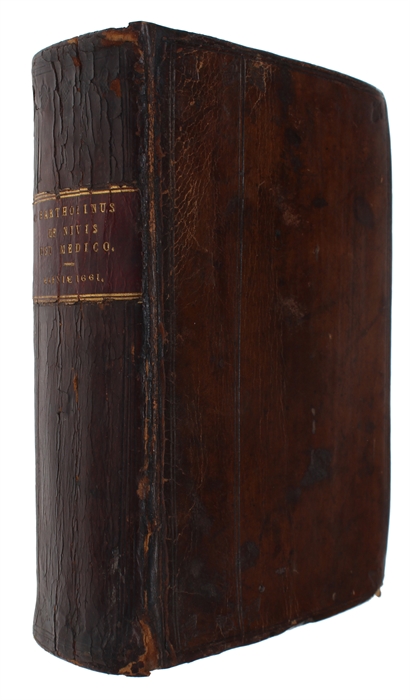"THE FIRST WORK AFTER AVICENNA TO DISCUSS THE USE OF SNOW AS AN ANESTHETIC"
BARTHOLIN,THOMAS.
De Nivis Usu Medico Observationes Varie (+) De Figura Nivis Dissertatio (+) Historiarum Anatomicarum et Medicarum Rariorum Centuria V et VI. (+) Thomas Bartholin: Responsio de Experimentis Anatomicis Bilsianis. (+) [J. Rohde:] Mantissa Anatomica ad Thomas Bartholinum.
Hafniæ (Copenhagen), Matthias Godiche, 1661.
8vo. In contemporary full calf with gilt lettering to spine. Gilt lettering to spine and tooled frames to boards. Leather to spine cracked. Small repair and previous owner's name to title-page. Light foxing throughout. (22), 232, (12), 42, (30), 386, (14), 40, 32 pp. + engraved plate.
First edition of Bartholin's important work on anesthetic: "The first work after Avicenna to discuss the use of snow as an anesthetic." (Garrison & Morton). "Chapter XXII of this historically important book makes the first known mention of the use of mixtures of ice and snow for freezing to produce surgical anesthesia. The author states that the technique was taught to him by one Marco Aurelio Severino of Naples. In order not to kill the tissues and cause gangrene, the ice-snow mixture was to be applied on the parts in narrow parallel lines. After a quarter of an hour feeling would be deadened and the part could be cut without pain. This may be the first mention of such a technique since the time of Avicenna." (Heirs of Hippocrates 326). Thomas Bartholin (1616-1680) was one of the leading physicians of his time, now remembered, among many other things, as the discoverer of the lymphatic system. He "was the most celebrated physician of his period in Denmark and perhaps in all of Europe". (Kronick, p. 81). He is considered "a typical representative of the "Curiosi naturae" of the 17th century with all their learning, diligence and insatiable spirit of curiosity... He belonged with all his heart to the learned period, and yet he made an anatomical-physiological discovery of high mark when he found, and demonstrated, a hitherto entirely unknown vascular system in animals, and later in man - the lymphatic." (Meisen, p. 25). He was a hugely influential and extremely productive man. Apart from his seminal discovery of the lymphatic system, he wrote a number of highly influential treatises, published a series of very influential anatomical papers, published his vast correspondence with other scientists, which has the character of a scientific archive at a time when there were not yet periodicals of natural science, provided us with the most extensive information about medicine in Denmark and about the conditions of the physicians, called attention to the significance of pathological anatomy, etc., etc., Heirs of Hippocrates 326.
Osler 1933.
Wellcome II, p. 107.
Garrison & Morton 5645.90
Order-nr.: 60138


![De Nivis Usu Medico Observationes Varie (+) De Figura Nivis Dissertatio (+) Historiarum Anatomicarum et Medicarum Rariorum Centuria V et VI. (+) Thomas Bartholin: Responsio de Experimentis Anatomicis Bilsianis. (+) [J. Rohde:] Mantissa Anatomica ad Th...](/images/product/60138b.jpg)
![De Nivis Usu Medico Observationes Varie (+) De Figura Nivis Dissertatio (+) Historiarum Anatomicarum et Medicarum Rariorum Centuria V et VI. (+) Thomas Bartholin: Responsio de Experimentis Anatomicis Bilsianis. (+) [J. Rohde:] Mantissa Anatomica ad Th...](/images/product/60138c.jpg)
![De Nivis Usu Medico Observationes Varie (+) De Figura Nivis Dissertatio (+) Historiarum Anatomicarum et Medicarum Rariorum Centuria V et VI. (+) Thomas Bartholin: Responsio de Experimentis Anatomicis Bilsianis. (+) [J. Rohde:] Mantissa Anatomica ad Th...](/images/product/60138d.jpg)
![De Nivis Usu Medico Observationes Varie (+) De Figura Nivis Dissertatio (+) Historiarum Anatomicarum et Medicarum Rariorum Centuria V et VI. (+) Thomas Bartholin: Responsio de Experimentis Anatomicis Bilsianis. (+) [J. Rohde:] Mantissa Anatomica ad Th...](/images/product/60138e.jpg)